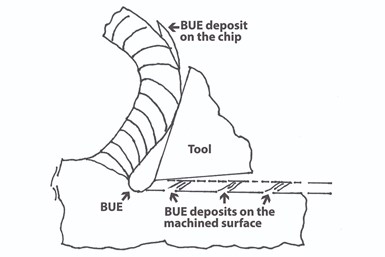Craftsman Cribsheet No. 100: Built Up Edge — What It Is and What To Do
Because Built Up Edge changes the effective geometry of the tool, it can have either positive or negative effects.
#pmpa

Built Up Edge (BUE) is the accumulation of workpiece material onto the rake face of the tool. This material welds under pressure and is separate from the chip. Schools teach that this is because the first material to contact the tool work-hardens, and hardness tests confirm this. Because BUE changes the effective geometry of the tool, it can have either positive or negative effects.
Positive Effects
- Less tool wear
- Lower power requirements
- Less contact of the workpiece with the tool (It contacts the BUE instead)
- Better surface finish and improved process capability

Built Up Edge (BUE) is the accumulation of workpiece material onto the rake face of the tool.
These effects are only beneficial if the BUE is thin and stable. Machining additives such as sulfur combine with manganese to form manganese sulfides. Manganese sulfide helps to control BUE because of its anti-weld properties. On resulfurized steels, BUE is usually stable and not a problem.
Negative Effects
- Poor tool life
- Poor and variable surface finish (As the BUE sloughs off the tool, it can weld to the workpiece)
- Loss of statistical capability on dimensional control
- Loss of uptime trying to troubleshoot the process
BUE is more likely on alloys that work harden. In order to get BUE under control, the steps that you take depend on the tool material.
For Carbide
- Decrease the feed. (Pressure welding usually is the culprit)
- Increase the speed
- Increase the rake angle or “hook”
- Get a better metalworking fluid (this includes getting the fines out of your existing MWF!)
- Get a different coating
For High Speed Steel (HSS)
- Reduce speed
If the tool is High Speed Steel (HSS), you may think you are in “oppositeland” when you discover that slowing down the speed reduces the buildup. On HSS, as speed (heat increases) so does the tendency to form BUE.
RELATED CONTENT
-
Craftsman's Cribsheet: How Sulfur and Manganese Improve Machinability
Because manganese and sulfur are intentionally added to the steel, manganese sulfides are present in the steel and at the edge of the tool where they optimize our machining process.
-
Precision Machining Jobs Account for 7 of the Top 25 High Paying Jobs — No College Degree Required
Those who hire in the precision machining industry have a persuasive point for prospective employees who don’t hold — or want to go into debt to hold — a college degree.
-
Steel Defects Seams on Rolled Steel Products
Learn how to detect and avoid defect seams in rolled steel products.


